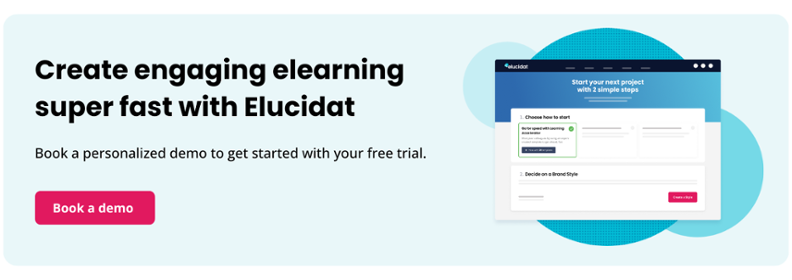Synchronous vs asynchronous learning: Choosing the right fit for your learning strategy
5 minute read
Did you know that 62% of organizations are now embracing blended learning? As more teams balance synchronous vs asynchronous learning, understanding the strengths of each is crucial. In this article, we break down both formats and show you how they fuel engagement, social connection, and flexibility – so you can choose the best approach to supercharge your learning strategy.

Table of contents
What is synchronous learning?
Imagine learners gathered in a physical classroom or engaging live in a virtual training session. These are both examples of synchronous learning, where everyone learns at the same time.
The biggest advantage? Real-time interaction. Think of learners messaging during a live webinar, acting out scenarios in a team workshop, or asking questions in a coaching session.
No surprise, then, that synchronous learning paves the way for active participation, social learning, and immediate feedback to clarify anything that is misunderstood. This makes it great for team-based training, live discussions, and hands-on learning experiences.
What is asynchronous learning?
Picture learners fitting elearning around their schedule, watching videos in a spare moment, or consulting digital documents on the fly. These are all examples of asynchronous learning, where learners access learning material at their own convenience.
While social interaction is possible with asynchronous learning, it’s not live. Learners might connect through comments, discussion boards, or shared tools.
The main advantage of asynchronous learning? Flexibility. Content is accessible anytime, anywhere, and learners can progress at the speed that works for them.
This makes asynchronous learning perfect for on-demand training, microlearning that fits into busy days, and spaced learning for better retention.
Comparing synchronous vs asynchronous learning: Key advantages and disadvantages
Which approach is best? Let’s compare synchronous vs asynchronous learning and see how they stack up.
Engagement and social connection
Synchronous learning is social, lending itself to engaging conversations, team activities, and a sense of community. Often, instructors can identify disengagement and address it on the spot.
Social connection in asynchronous learning requires more creativity. Elearning features like gamification and social polls can bridge the gaps between learners. But the true key to engagement lies in carefully crafted, interactive content.
Flexibility and accessibility
Synchronous learning poses scheduling challenges, especially for remote or global teams. Time zones, work schedules, and logistical issues can create barriers. If a learner can’t attend, they miss out.
Asynchronous learning removes these obstacles, letting learners engage at their convenience. It’s especially valuable for accommodating accessibility needs. Content can be tailored to diverse needs without relying on live participation.
Scalability and implementation costs
For small groups, synchronous learning can be quick and cost-effective. But as the audience grows, so do the challenges. Scaling to larger groups brings higher costs, more complex coordination, and a greater risk of technical hiccups.
Asynchronous learning can be costly to create upfront. But when it comes to scalability, that’s where this format truly shines. Once created, content can reach thousands of learners with minimal extra expense.
Blended learning: Combining synchronous and asynchronous learning
Choosing between synchronous vs asynchronous learning isn’t always necessary. What if you could use the best of both? Blended learning does just that, combining multiple approaches into a single learning experience.
Imagine you’re delivering product knowledge training. Here’s a potential blend:
- Start with an asynchronous digital activity to assess existing knowledge.
- Follow up with a synchronous discussion of the answers in small groups.
- Conclude with an asynchronous elearning module to provide detailed product information.
You get the flexibility and scalability benefits of asynchronous learning. Meanwhile, synchronous interactions boost engagement, encourage social learning, and offer opportunities for feedback and clarification.
Choosing between synchronous vs asynchronous learning for your training strategy
Deciding between synchronous vs asynchronous learning, or a blend of both? Make the right choice for your training strategy by asking yourself three simple questions.
1. What’s the purpose of your learning?
Work out what you’re trying to achieve and why.
- For hands-on skills that benefit from live demonstration and practice, synchronous learning that gets people together is ideal.
- Asynchronous learning works well for detailed information, spaced learning, personalised learning, on-demand training, or content learners may need to revisit.
Don’t forget to consider goals beyond learning. Aiming to boost motivation or foster team connection? That might also influence your approach.
2. Who is the audience?
Understand who your training is for by asking:
- Who are your learners, and what challenges do they face?
- Where are they located, and what are their schedules?
- Do they all need the same content, or are there variations?
When weighing up synchronous vs asynchronous learning, consider both practicality – scheduling, accessibility, scalability – and learner needs.
3. What other factors shape your choice?
When choosing between synchronous vs asynchronous learning, organizational considerations matter too. Ask yourself:
- What’s your timeline? Synchronous learning is quicker to implement. Asynchronous takes longer but is reusable long-term.
- What’s your budget? Synchronous costs less upfront, but needs ongoing instructor time. Asynchronous costs more initially but less over time.
- What’s your technical infrastructure like? Stable internet is crucial for virtual synchronous learning. Asynchronous usually requires a reliable content-hosting platform.
By addressing these three questions – purpose, audience, and practical constraints – you can confidently choose between synchronous, asynchronous, or blended learning to meet your goals.
Conclusion
When it comes to synchronous vs asynchronous learning, each approach offers distinct benefits.
Synchronous learning drives active participation, real-time engagement, and social interaction. Meanwhile, asynchronous learning excels in providing flexibility, supporting self-directed learning, and reaching large audiences.
Why not take advantage of both? A learning blend combines the strengths of the two types of learning to optimize engagement, flexibility, and scalability.
With Elucidat, creating personalized, blended learning experiences has never been easier. Ready to explore the possibilities? Book a demo with Elucidat today.




